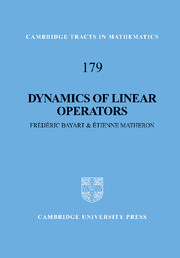Book contents
- Frontmatter
- Contents
- Introduction
- 1 Hypercyclic and supercyclic operators
- 2 Hypercyclicity everywhere
- 3 Connectedness and hypercyclicity
- 4 Weakly mixing operators
- 5 Ergodic theory and linear dynamics
- 6 Beyond hypercyclicity
- 7 Common hypercyclic vectors
- 8 Hypercyclic subspaces
- 9 Supercyclicity and the Angle Criterion
- 10 Linear dynamics and the weak topology
- 11 Universality of the Riemann zeta function
- 12 An introduction to Read-type operators
- Appendices
- References
- Notation
- Author index
- Subject index
10 - Linear dynamics and the weak topology
Published online by Cambridge University Press: 10 December 2009
- Frontmatter
- Contents
- Introduction
- 1 Hypercyclic and supercyclic operators
- 2 Hypercyclicity everywhere
- 3 Connectedness and hypercyclicity
- 4 Weakly mixing operators
- 5 Ergodic theory and linear dynamics
- 6 Beyond hypercyclicity
- 7 Common hypercyclic vectors
- 8 Hypercyclic subspaces
- 9 Supercyclicity and the Angle Criterion
- 10 Linear dynamics and the weak topology
- 11 Universality of the Riemann zeta function
- 12 An introduction to Read-type operators
- Appendices
- References
- Notation
- Author index
- Subject index
Summary
Introduction
This chapter is devoted to hypercyclicity and supercyclicity with respect to the weak topology of a given Banach space. Let X be a separable infinite-dimensional Banach space. An operator T ∈ L(X) is said to be weakly hypercyclic if it is hypercyclic when considered as an operator on the topological vector space (X, ω), in other words, if there exists some vector x ∈ ω whose T-orbit O(x, T) is weakly dense in X. Such a vector x is of course called a weakly hypercyclic vector for T. One defines in the same way weakly supercyclic operators and weakly supercyclic vectors.
One unpleasant fact immediately comes to mind when considering these defi- nitions. Up to now, we have almost exclusively concentrated on hypercyclicity or supercyclicity for linear operators acting on completely metrizable topological vector spaces; however, the weak topology of an infinite-dimensional Banach space is neither Baire nor metrizable. This means first that we have no Hypercyclicity Criterion at our disposal and second that we must be careful with sequences, since a vector z ∈ X may belong to the weak closure of some T-orbit O(x, T) without being the weak limit of a sequence (Tnk (x)).
Having said that, the first natural question is whether weak hypercyclicity and supercyclicity really make sense, i.e. whether there exist weakly hypercyclic or supercyclic operators which are not already hypercyclic or supercyclic with respect to the norm topology. Fortunately the answer is positive, but this is a non-trivial result.
- Type
- Chapter
- Information
- Dynamics of Linear Operators , pp. 230 - 263Publisher: Cambridge University PressPrint publication year: 2009

